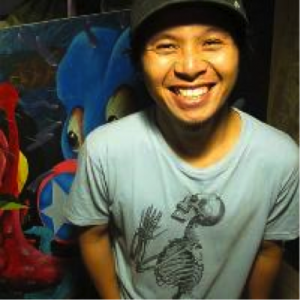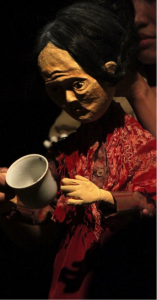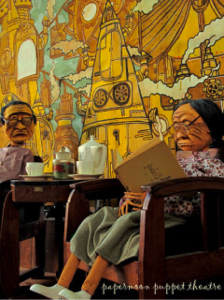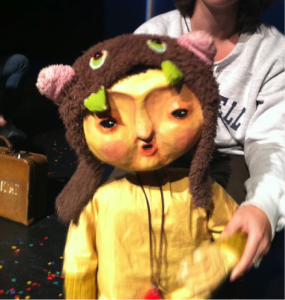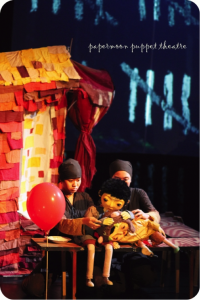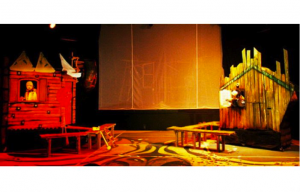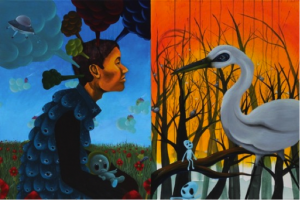When did you become interested in being an artist (puppet-making or otherwise)?
“I start my career as a visual artist in 2004, and started making puppets when Papermoon was founded in 2006.”
Where exactly did you go to school? What did you study while you were there?
“I received my fine art education at the Indonesia Institute of the Arts, Yogyakarta, Indonesia.
What was your experience as a student like? Did you enjoy it? What do you think you learned in school that has been the most helpful? If you could redo being a student again, what would you do differently?
“So, about my experience as a student, it’s a bit hard to tell, because I didn’t finish my art school. I mostly work outside campus, and I’m not focused to finish my study. My 2 years of study in art school were exciting, and sharing creativity was the most exciting.
If I become a student again, hmmm…I would want to find a scholarship to study abroad, even in Asia, Europe, or the US.”
What do you do in Papermoon? What is your average day like? What’s the favorite thing you do with the Papermoon Puppet Company? What do you find most challenging?
“In Papermoon, I’m an artistic director. Everyday, except when I’m doing my own art, I design and experiment with puppets. My favorite thing in Papermoon is that, when we do rehearsals with the puppet that I make, I can see many possibilities in the puppet. As a visual artist I feel my painting go alive with [rehearsals]. And the most challenging: I have to be patient and understand what it is my puppet can do or can’t do based on the experience or interpretation of the puppeteer who manipulates my puppet.”
What skills do you find to be the most important in working in the puppet field? How did you learn these skills?
“Of course making puppets and building the stage (not just technically but also conceptually). Thank God the Internet exists now, so that we can learn and experiment easily…”
How much of your artistic work do you do with Papermoon, and how much of your work is done by yourself? Besides puppets, what other media do you like to use?
“These last 3 years, I’ve worked a lot with Papermoon. I just did my solo exhibition in September 2011. I do drawing, painting, installation, and now I am starting to make printmaking like etching and dry point.”
Why did you choose to work with puppetry? What do you think are the positives and negatives of creating art through puppets?
“I work with puppets, but it’s not about choosing. I just started doing it and, along the way, I felt the process fit with my idea. I still believe that, in art, every medium has it’s own message, both negative and positive. I’m not sure I can use those words [positive and negative] to determine whether a form of art works or not. When you decide what kind of art you will make, you will find the richness of it in the process. If not, you’ll find out later.”
What’s your favorite puppet you’ve ever created?
“Me and Ria always said our favorite piece is our next performance!
Ya Tupu (the little boy in Mwathirika) is my favorite.”
How do you feel your art works with others in a performance?
“I feel rich. There are many points of view directly coming to me during the performance’s creation, and negotiating in art is always challenging.”
How did you get to where you are today? What experiences did you have, what actions did you choose, what connections did you make, etc. that led you to be working with Papermoon?
“Sometimes I’m not really sure with what happen now, and why, but I just believe that if I make something seriously and intensely, the universe will accompany me. I always learn from others, and at the same time try to make my own stuff.”
What advice would you give young artists (me and Alana) who are interested in exploring puppetry as art? How could we get started, and where should we get started? I know you guys are very far away, but can you suggest any particular internships or opportunities that I might want to look into? They don’t have to be over here in the USA.
“First, just experiment as much as you can. You will feel in one particular level of your process that “this is what I want, that’s based on my experience.” After that, you will see many possible puppet performances. You’re lucky; in US, there is a lot of contemporary puppet show. In Indonesia, we only have traditional puppet, which is good but not enough for me to explore more with this medium.
For internships…hmmm. You can try Bread and Puppet in Vermont, or Saint Ann Warehouse in Dumbo Brooklyn. Or you can come to Asia to see many different forms of puppetry.”
Also, would it be okay if my sculpture professor or some other students followed up with you later on if they have any questions? I would assume email would be the best way to contact you?
“Yes, sure!”
The following works are all done by Iwan Effendi. The first eight come from his work in Papermoon Puppet Theatre. The latter two are his personal works.
